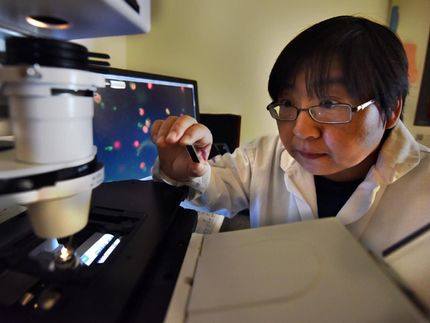A major step in making better stem cells from adult tissue
Advertisement
A team led by scientists from The Scripps Research Institute has developed a method that dramatically improves the efficiency of creating stem cells from human adult tissue, without the use of embryonic cells. The research makes great strides in addressing a major practical challenge in the development of stem-cell-based medicine. The findings were published in Nature Methods.
The new technique, which uses three small drug-like chemicals, is 200 times more efficient and twice as fast as conventional methods for transforming adult human cells into stem cells (in this case called "induced pluripotent stem cells" or "iPS cells").
"Both in terms of speed and efficiency, we achieved major improvements over conventional conditions," said Scripps Research Associate Professor Sheng Ding, Ph.D., who led the study. "This is the first example in human cells of how reprogramming speed can be accelerated. I believe that the field will quickly adopt this method, accelerating iPS cell research significantly."
In addition to its significant practical advantages, the development of the technique deepens the understanding of the biology behind the transformation of adult human cells into stem cells.
The creation of human iPS cells was first announced in December 2007 by two labs, one in Japan and another in Wisconsin. While the work was a major breakthrough, it left two major challenges for the field to solve before iPS cell therapy could be considered of any potential practical use. The first involved safety, since the technique relied on potentially harmful genetic manipulation, and worse yet, the insertion of two known cancer-causing genes (c-Myc and Oct4). The second problem was the length and inefficiency of the iPS cell process, which had a success rate of roughly one in 10,000 cells and took about four weeks from start to finish.
Ding and colleagues essentially solved the first problem, the reliance on genetic manipulation, earlier this year in a paper published in Cell Stem Cell. In the paper, the researchers demonstrated that they could use purified proteins to transform adult cells all the way back to the most primitive embryonic-like cells, avoiding the problems associated with inserting genes. In the current paper, the team makes major strides in solving the second problem, efficiency.
In developing the improved method, Ding drew on his knowledge of biology. He decided he would focus his efforts on manipulating a naturally occurring process in cells, in particular in a type of adult cell called fibroblasts, which give rise to connective tissue. This naturally occurring process — called MET (mesenchymal to ephithelial cell transition) — pushes fibroblasts closer to a stem-cell-like state. If he could manipulate such a fundamental process to encourage MET and the formation of stem cells, Ding reasoned, such a method would be both safer and more direct than hijacking other aspects of biology, for example those directly involved in cancer.
Ding and colleagues tested a number of drug-like molecules, looking for those that inhibited the TGFb (transforming growth factor beta) and the MEK (mitogen-activated protein kinase) pathways, which are known to be involved in the MET process. The researchers identified the most active compounds, then looked at their effects on stem cell creation when used singly and in combination.
The researchers found two chemicals — ALK5 inhibitor SB43142 and MEK inhibitor PD0325901 — used in combination were highly effective in promoting the transformation of fibroblasts into stem cells. And the two-chemical technique bested the efficiency of the classic genetic method by 100 times. But the researchers thought they might be able to do even better.
Attempting to increase the efficiency of the process even further, the team decided to enlist another natural pathway, the cell survival pathway. After screening a library of compounds targeting this pathway, the team focused on a novel compound called Thiazovivin. The researchers found that a technique using Thiazovivin in combination with the two previously selected chemicals, SB43142 and PD0325901, beat the efficiency of the classic method by 200 times. In addition, while the classic method required four weeks to complete, the new method took two weeks.
In addition to its virtues of speed and efficiency, Ding emphasizes that the safety profile of the new method is highly promising. Not only is the method based on natural biological processes, he said, but also the type of molecules used have all been tested in humans.





















































